
The Solar-Terrestrial Centre of Excellence (STCE) is a collaborative network of the Belgian Institute for Space Aeronomy, the Royal Observatory of Belgium and the Royal Meteorological Institute of Belgium.
 |
Published by the STCE - this issue : 5 Dec 2013. The Solar-Terrestrial Centre of Excellence (STCE) is a collaborative network of the Belgian Institute for Space Aeronomy, the Royal Observatory of Belgium and the Royal Meteorological Institute of Belgium. |
| Archive of the newsletters | Subscribe to this newsletter by mail |
The long-awaited and much-hyped comet ISON surprised astronomers and solar physicists when it mysteriously failed to appear in images from extreme-ultraviolet (EUV) solar telescopes on Thursday. The SWAP solar telescope, on board the Belgium-based ESA mission PROBA2, conducted an extraordinary campaign to image ISON, but failed to detect any sign of the unusual comet.
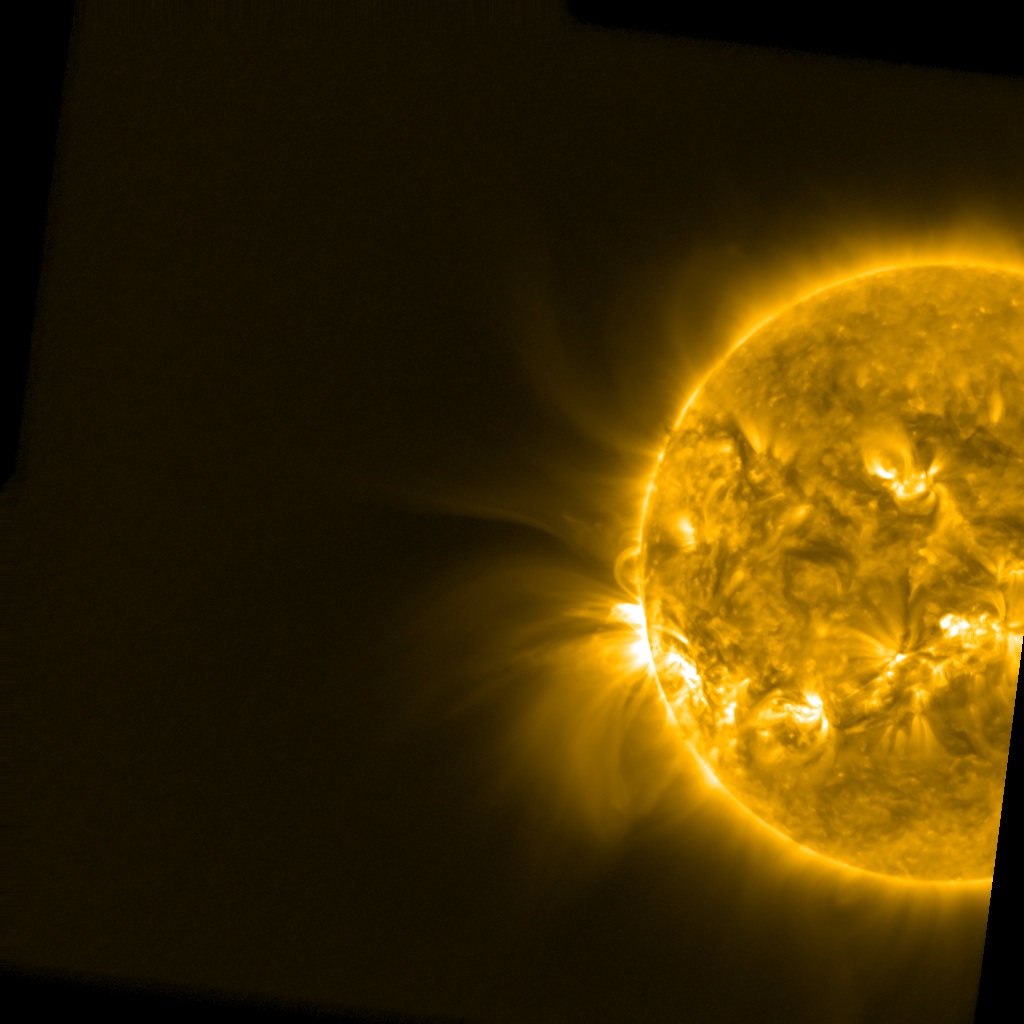
Previous comets, so-called sungrazers, which follow orbits that carry them to within an astronomical hairsbreadth of the Sun, have appeared bright in EUV images as they raced through the Sun’s atmosphere and skimmed its scorching surface. Comet Lovejoy, which had its own close encounter with the Sun in 2011, was clearly visible in images from PROBA2. Observations of Lovejoy helped shed light not only on comets, but also on the Sun’s magnetically active atmosphere as the comet left a trail that traced out flows along the magnetic field of the solar corona.
Since the first spaceborne solar ultraviolet telescopes were launched in the 1990s, only a handful of comets have passed close enough to the Sun to be visible to these instruments. Scientists at the Royal Observatory of Belgium, which operates PROBA2, had hoped that ISON would be the newest addition to the list, answering questions not only about the Sun and comets in general, but also the origins of the solar system itself.
Comet ISON, which has orbited the Sun among the objects of the Oort Cloud for almost 4.5 billion years, perhaps as much as a light-year away from the inner solar system, has remained largely untouched since the time of the solar system’s formation. Since it was first detected nearly a year ago, astronomers hoped its passage would offer a unique glimpse of the state of our solar system in its earliest moments.
“We made every effort to observe Comet ISON,” said Dr. Daniel Seaton, lead scientist for SWAP at the Royal Observatory of Belgium. “Unfortunately, the comet simply didn’t appear in our images. In principle, we had every reason to think our telescope would see it, so why we did not only deepens the mystery of a perplexing comet.”
Comet ISON, which passed the Sun’s surface at a height of only about 1.2 million kilometers, had already puzzled astronomers with other strange behavior before it reached perihelion, its point of closest approach to the Sun.
“The last comet we saw with SWAP, Comet Lovejoy, passed barely 100,000 km from the Sun’s surface,” said Dr. Seaton. “That’s closer than the Earth is to the Moon. So one possibility is that Comet ISON was simply too far away from the Sun to be visible. There are quite a few factors that determine whether or not SWAP can see something.”
Each UV telescope trained on the Sun has a particular specialty. SWAP’s specialty is its ability to make observations of iron and oxygen atoms in the solar corona as far distant from the Sun as 2 million kilometers, much farther than most other active solar observatories.
“One possibility is that the comet, despite its close approach to the Sun, simply wasn’t composed of material our imager can actually see. Another is that the material evaporated from the comet didn’t reach the million degree temperatures which would allow it to be seen with SWAP,” said Dr. Seaton.
Some scientists speculated that the comet had simply disintegrated as it approached the Sun, but ISON appears at least partially intact as it begins its recession to the deepest reaches of the solar system once again. Dr. Laurel Rachmeler, also of the Royal Observatory of Belgium said that the comet would remain a mystery for solar physicists and other astronomers to puzzle over in the months to come.
“Of course we were hoping to see something a little more spectacular in our telescope,” she said, “but there is still plenty to do before we can solve this little riddle. The suspense for us has passed, but now the fun part starts as we begin to fit all of our information together. ”
As the mystery deepens, scientists around the world continue to train their telescopes and instruments on whatever is left of the receding Comet ISON. SWAP scientists, meanwhile, are left to delve deeper into the puzzle of just why their efforts to image this comet were unsuccessful, unlike ISON’s sungrazing cousin Lovejoy, two years ago.
“It’s a mystery for sure,” said Dr. Seaton, “but a non-detection is still important information. Our hope is that our data — or rather, our lack of data — will be combined with images and observations from the global effort to understand this comet and will help give us new insight into some of the most distant bodies in our solar system.”
Previously appeared: No Clues from Comet ISON, check http://proba2.oma.be/news/no-clues-from-ison
SWAP contact: Dr. Daniel Seaton and Dr. Laurel Rachmeler, Solar-Terrestrial Centre of Excellence
Solar flare activity remained low during the week.
In order to view the activity of this week in more detail, we suggest to go to the following website from which all the daily (normal and difference) movies can be accessed: http://proba2.oma.be/ssa
This page also lists the recorded flaring events.
A weekly overview movie can be found here (SWAP week 192).
http://proba2.oma.be/swap/data/mpg/movies/WeeklyReportMovies/WR192_Nov25_Dec01/weekly_movie_2013_11_25.mp4
Details about some of this week's events, can be found further below.
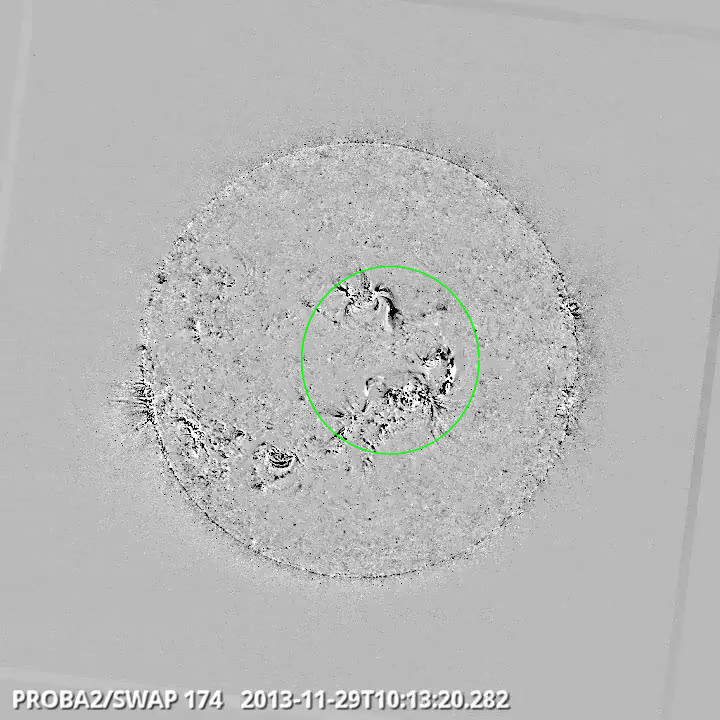
Flows in the center @ 10:13 - SWAP difference image
Find a movie of the events here (SWAP difference movie)
http://proba2.oma.be/swap/data/mpg/movies/WeeklyReportMovies/WR192_Nov25_Dec01/Events/20131129_Flows_Center_1013_swap_diff.mp4
Find a movie of the events here (SWAP movie)
http://proba2.oma.be/swap/data/mpg/movies/WeeklyReportMovies/WR192_Nov25_Dec01/Events/20131129_Flows_Center_1013_swap_movie.mp4
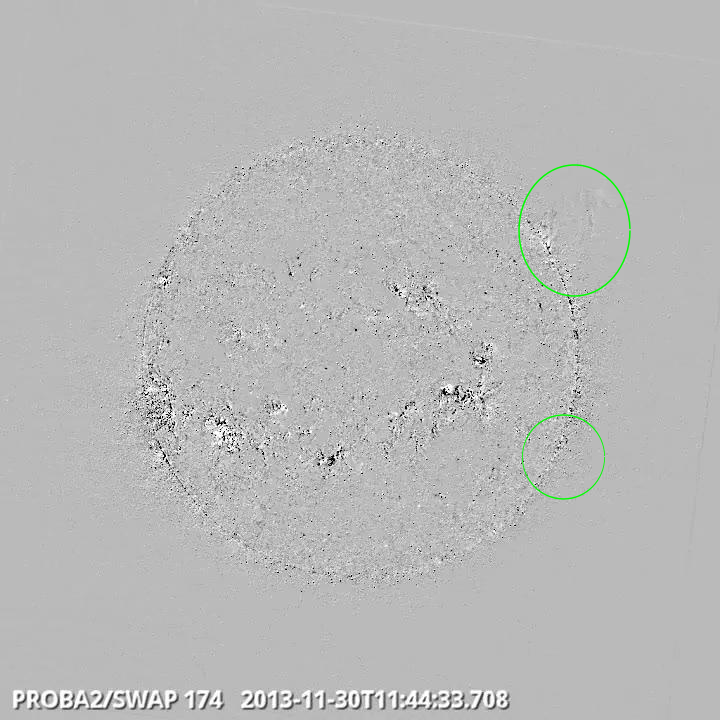
Eruptions on the eastern limb @ 11:44 - SWAP difference image
Find a movie of the events here (SWAP difference movie)
http://proba2.oma.be/swap/data/mpg/movies/WeeklyReportMovies/WR192_Nov25_Dec01/Events/20131130_Eruptions_NorthWest_1144_swap_diff.mp4
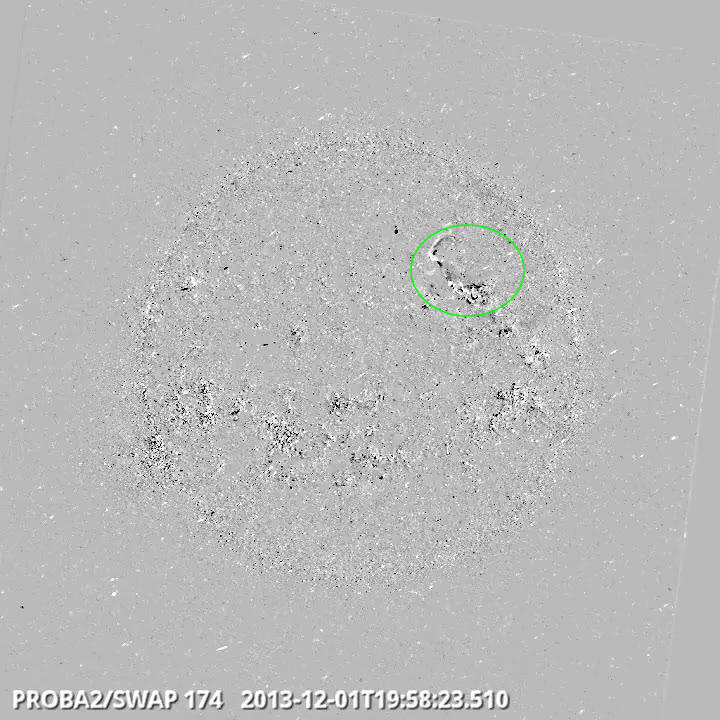
Eruption on the north west quad @ 19:58 - SWAP difference image
Find a movie of the events here (SWAP difference movie)
http://proba2.oma.be/swap/data/mpg/movies/WeeklyReportMovies/WR192_Nov25_Dec01/Events/20131201_Eruption_NorthWestQuad_1958_swap_diff.mp4
Find a movie of the events here (SWAP movie)
http://proba2.oma.be/swap/data/mpg/movies/WeeklyReportMovies/WR192_Nov25_Dec01/Events/20131201_Eruption_NorthWestQuad_1958_swap_movie.mp4
NOAA AR 1904 was on the front stage when it comes to flaring activity in the first part of the week, not literally of course because the region was near the west limb. Even when the associated sunspot group was not visible anymore, GOES kept on noticing flaring activity from that region until it rotated completely in the shadow on the far-side of the Sun where its coronal loops could not peek anymore over the solar limb. November 28 and 29, NOAA AR 1907 and 1908 took over the C-flare duty. November 30, NOAA 1909 appeared in the east, on December 1, 1912 came into view. Both produced C-flares.
There were 3 (partial) halo CME's.
The one of November 27 was linked with a filament eruption. It was detected by CACTus at 15:13UT. The bulk of the plasma was ejected to the North. Check http://sidc.oma.be/cactus/catalog/LASCO/2_5_0/qkl/2013/11/CME0163/CME.html
The CME could cause a glancing blow but there was no clear evidence of this.
The November 29 CME which came into the LASCO/C2 field of view (FOV) at 17:36UT. There was no on-disk signature. The CME was therefore determined as back-sided and was probably linked with the activity of NOAA AR 1904.
A similar story for the November 30 CME which came into the LASCO/C2 FOV at 13:48UT. There was again no on-disk signature. Flaring activity and a mass ejection around that time was although visible with STEREO B EUI 195. This CME was therefore determined as back-sided.
The picture below is taken with the STEREO Behind EUVI 195 imager. It shows the left back side of the Sun. The coronal structures on the right are already visible on the front side of the solar disk. What is in the middle of the picture can not be seen by satellites like SDO which is orbiting the Earth and has always the view of the Sun facing the Earth. The active region that might be responsible for the coronal mass ejection is indicated.
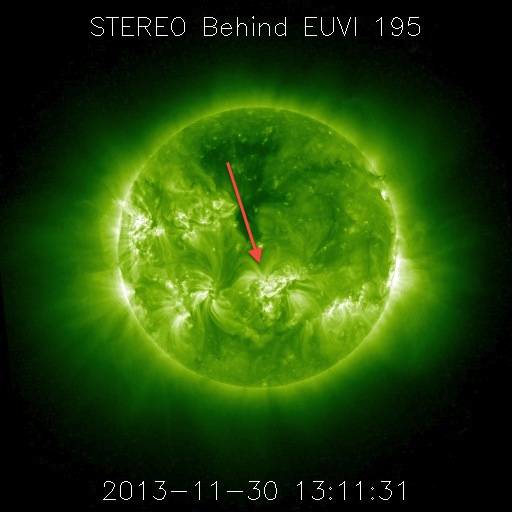
The total interplanetary magnetic field increased in strength on November 29. The plasma became at that moment slightly denser. The solar wind speed and temperature started to increase gradually. This is a typical signature for a coronal hole.
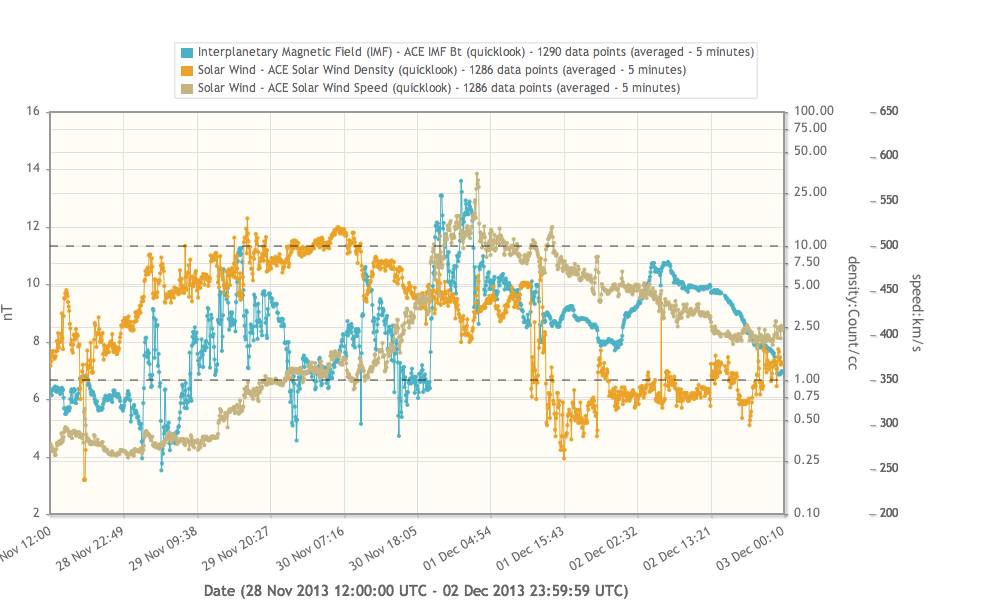
We can trace the co-rotating interaction region and the fast solar wind back to the small northern coronal hole that reached the central meridian on November 24. The geomagnetic field was slightly distorted as the planetary and local (Dourbes) K index reached values up to 3 from November 29 to December 1. Kp was 4 for one 3-hour interval on November 30, similar the local K in Dourbes reached also 4 that day.
The Kp and local K Dourbes were equal 2 or even below for the other days of the week.
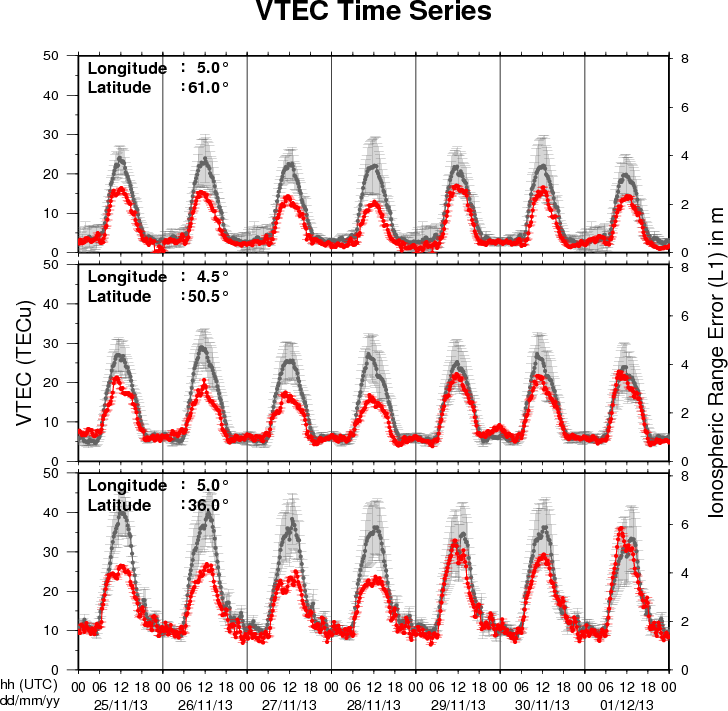
The figure shows the time evolution of the Vertical Total Electron Content (VTEC) (in red) during the last week at three locations:
a) in the northern part of Europe(N61°, 5°E)
b) above Brussels(N50.5°, 4.5°E)
c) in the southern part of Europe(N36°, 5°E)
This figure also shows (in grey) the normal ionospheric behaviour expected based on the median VTEC from the 15 previous days.
The VTEC is expressed in TECu (with TECu=10^16 electrons per square meter) and is directly related to the signal propagation delay due to the ionosphere (in figure: delay on GPS L1 frequency).
The Sun's radiation ionizes the Earth's upper atmosphere, the ionosphere, located from about 60km to 1000km above the Earth's surface.The ionization process in the ionosphere produces ions and free electrons. These electrons perturb the propagation of the GNSS (Global Navigation Satellite System) signals by inducing a so-called ionospheric delay.
See http://stce.be/newsletter/GNSS_final.pdf for some more explanations ; for detailed information, see http://gnss.be/ionosphere_tutorial.php
Start : 2014-04-27 - End : 2014-05-02
The EGU General Assembly 2014 will bring together geoscientists
from all over the world to one meeting covering all disciplines of
the Earth, planetary and space sciences. The EGU aims to provide a
forum where scientists, especially early career researchers, can
present their work and discuss their ideas with experts in all
fields of geosciences.
Slides presented during the ESWW10 Splinter "Next Generation SPENVIS" on Tuesday November 19th, 2013, by Kruglanski Michel
The Space Environment Information System (SPENVIS, http://www.spenvis.oma.be/) is a ESA web-based interface for assessing the space environment and its effects on spacecraft systems and crews under continual development since 1996 and used by a worldwide community. This ESWW10 splinter meeting offered the opportunity to SPENVIS users and model developers to meet the SPENVIS development team and share their feedback and questions. Latest updates on the development of the new system (Next Generation SPENVIS) were reported.
http://www.spaceweather.eu/en/repository/show?id=484